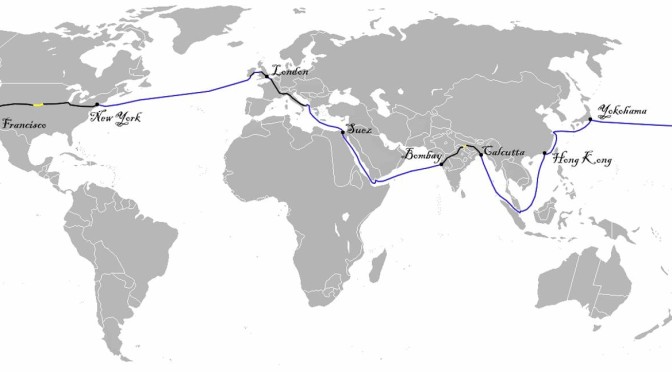When I was a child, one of my favorite books was (and still is) Jules Verne’s Around the World in Eighty Days. Published in 1873, the novel tells the story of Phileas Fogg, an English gentleman, and his newly employed French valet Passepartout.
Fogg is a member of the Reform Club, a private members club on the south side of Pall Mall in central London. While the club members talking about the recent advances in technology, especially the new transportation methods including railway, Fogg sees an article in The Daily Telegraph stating that “with the opening of a new railway section in India, it is now possible to travel around the world in 80 days”.
Around the World in Eighty Days? Was it possible?
Other club members are skeptical about this claim. But Fogg insists it is doable.
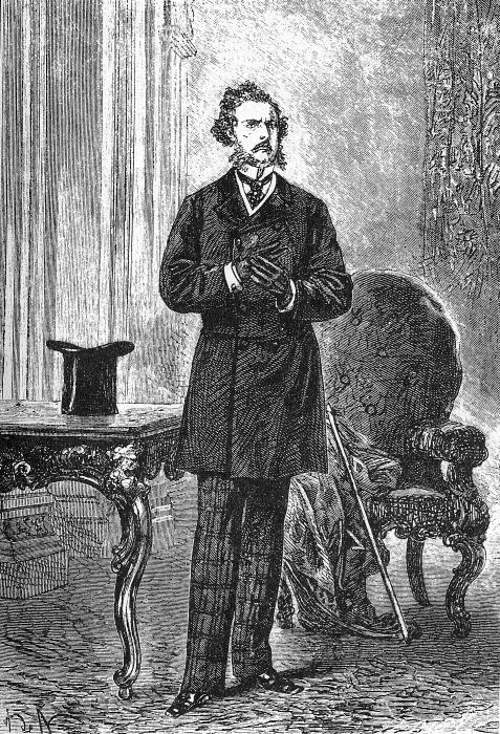
Long story short, after a lot of adventures, problems and difficulties, Fogg returns back home “almost” in time – but he misses the train and arrives London five minutes late, certain he lost the wager.
Fogg apologizes to Aouda (an Indian princess rescued by himself and Passepartout, at the death of her husband, she was about to be sacrificed by Hindu monks) for bringing her with him since he now has to live in poverty and cannot support her. Aouda confesses that she loves him and asks him to marry her. He calls for Passepartout to notify the minister.
The following day, at the minister’s, Passepartout learns that he is mistaken in the date, which he takes to be Sunday, December 22, but which is actually Saturday, December 21, because the party traveled eastward, gaining a day. The wager can still be won, but there is very little time left.
Passepartout hurries to inform Fogg, who reaches the Reform Club just in time to win the wager. Fogg marries Aouda and the journey around the world is complete and in 80 days.
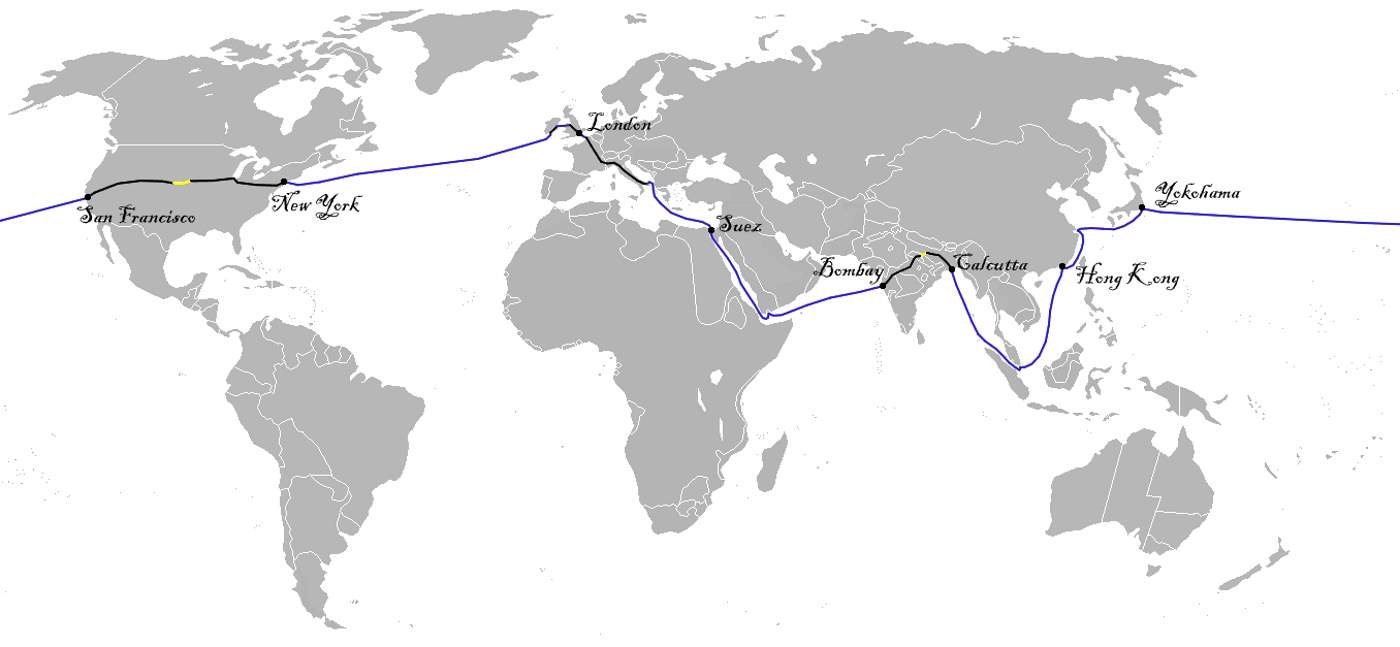
Inspirations of the Around the World in Eighty Days novel
During Verne’s lifetime, in the 19th century, technology advanced rapidly. The railway became a traveling standard, and steam-powered ships got stronger and safer.
In particular, three technological breakthroughs occurred in 1869-70 that made a tourist-like around-the-world journey possible for the first time: the completion of the First Transcontinental Railroad in America (1869), the linking of the Indian railways across the sub-continent (1870), and the opening of the Suez Canal (1869).
These events started at an age of fully global tourism that could be enjoyed in relative comfort and safety. It sparked the imagination that anyone could sit down, draw up a schedule, buy tickets, and travel around the world, a feat previously reserved for only the most heroic and hardy of adventurers.
Real around the world voyagers
George Francis Train
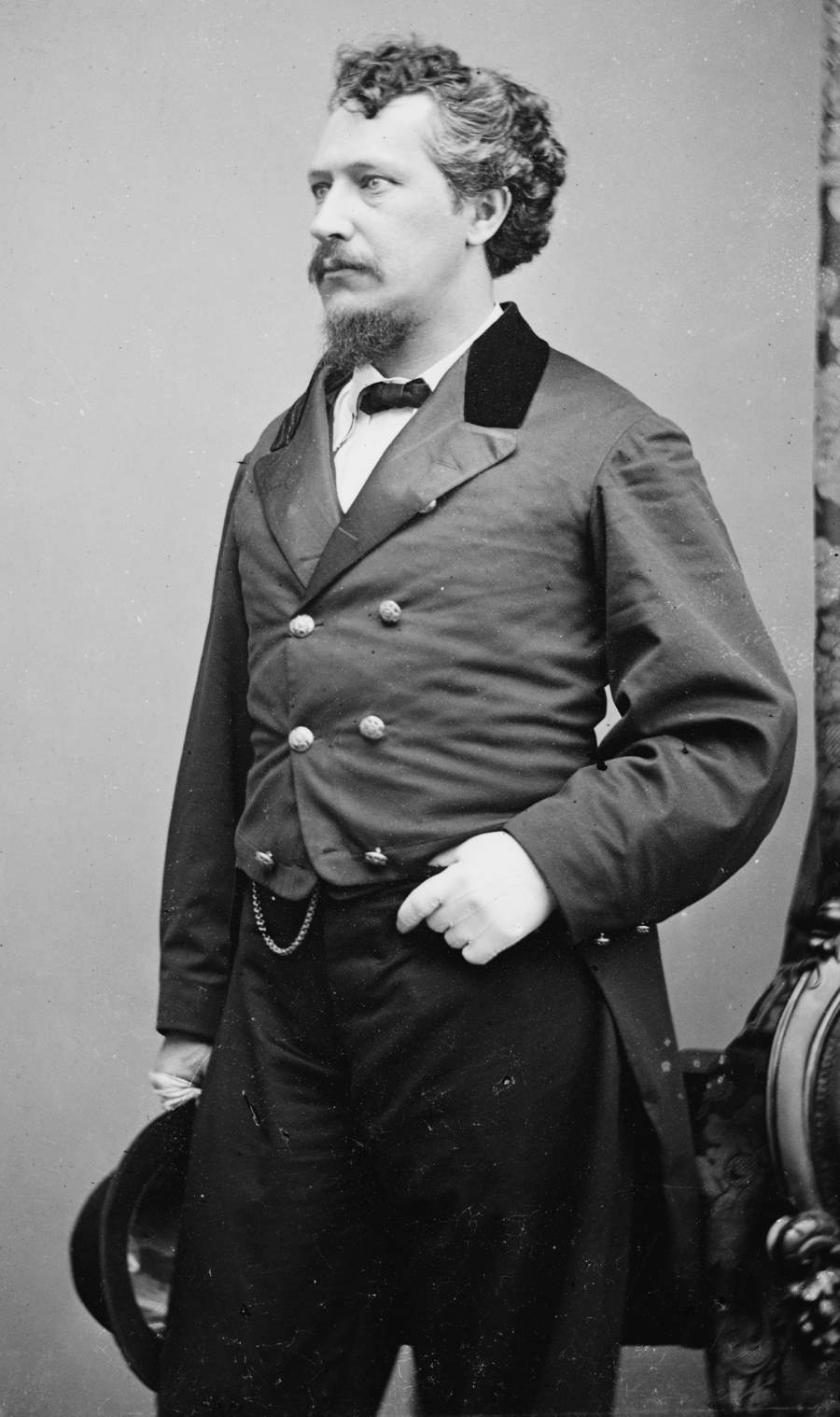
A possible inspiration for the novel was the American entrepreneur and traveler George Francis Train (March 24, 1829 – January 5, 1904), who made three trips around the world, including one in 80 days in 1870, which was covered by many newspapers. Similarities include the hiring of a private train and being imprisoned. Train later claimed, “Verne stole my thunder. I’m Phileas Fogg”.
After the book was translated into English by G.M. Towle and N. D’Anvers, it inspired many people in English-speaking countries to try to follow in the footsteps of Fogg’s fictional circumnavigation.
Nellie Bly’s journey (1889)
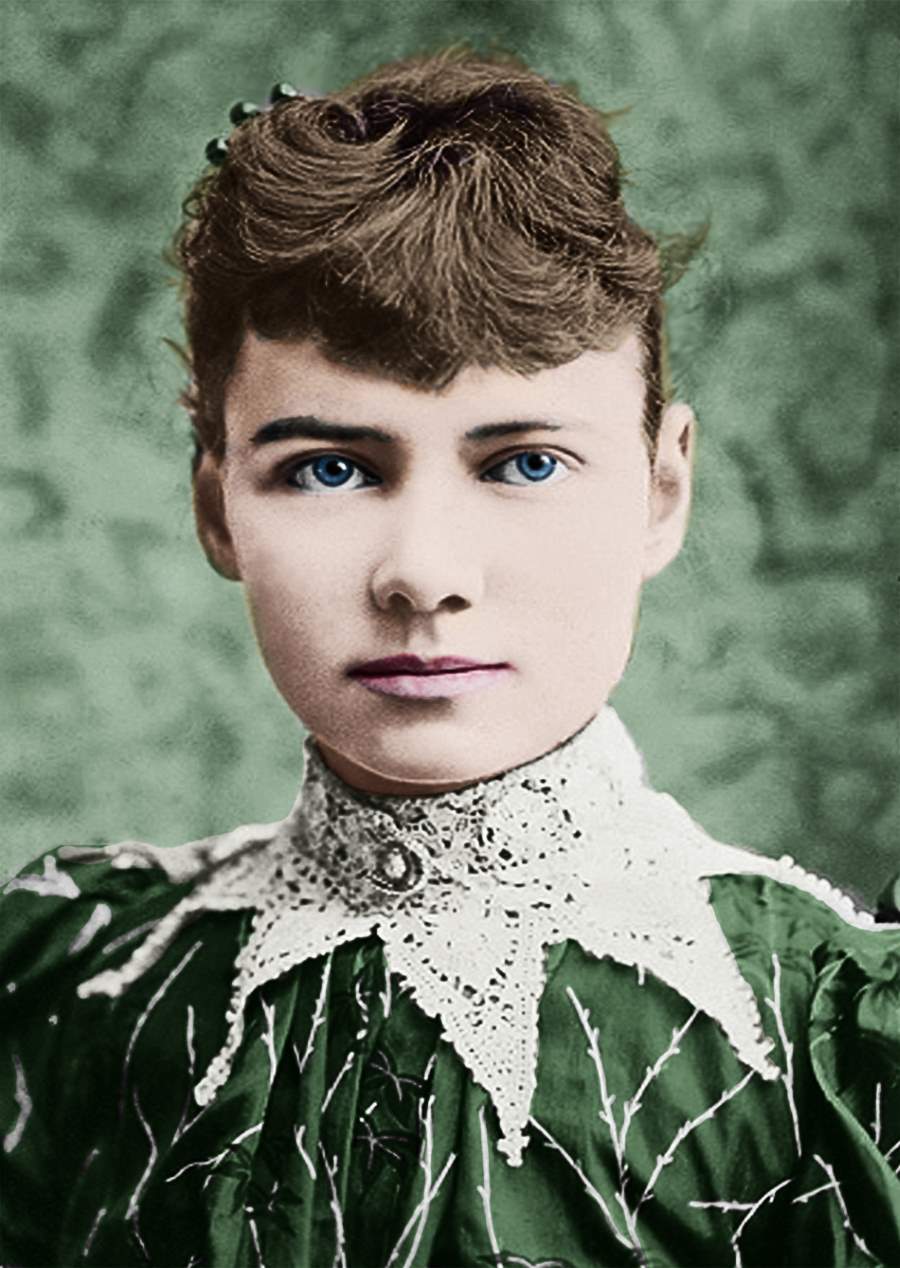
Nellie Bly (May 5, 1864 – January 27, 1922) was the pen name of American journalist Elizabeth Cochrane Seaman. She undertook to travel around the world in 80 days for her newspaper, the New York World. She managed to do the journey within 72 days, meeting Verne in Amiens. Her book Around the World in Seventy-Two Days became a best seller.
To sustain interest in the story, the New York World organized a “Nellie Bly Guessing Match” in which readers were asked to estimate Bly’s arrival time to the second, with the Grand Prize consisting at first of a free trip to Europe and, later on, spending money for the trip.
During her travels around the world, Bly went through England, France (where she met Jules Verne in Amiens), Brindisi, the Suez Canal, Colombo (Ceylon), the Straits Settlements of Penang and Singapore, Hong Kong, and Japan. The development of efficient submarine cable networks and the electric telegraph allowed Bly to send short progress reports, although longer dispatches had to travel by regular post and thus were often delayed by several weeks.
Bly traveled using steamships and the existing railroad systems, which caused occasional setbacks, particularly on the Asian leg of her race. During these stops, she visited a leper colony in China and, in Singapore, she bought a monkey.
Elizabeth Bisland Wetmore
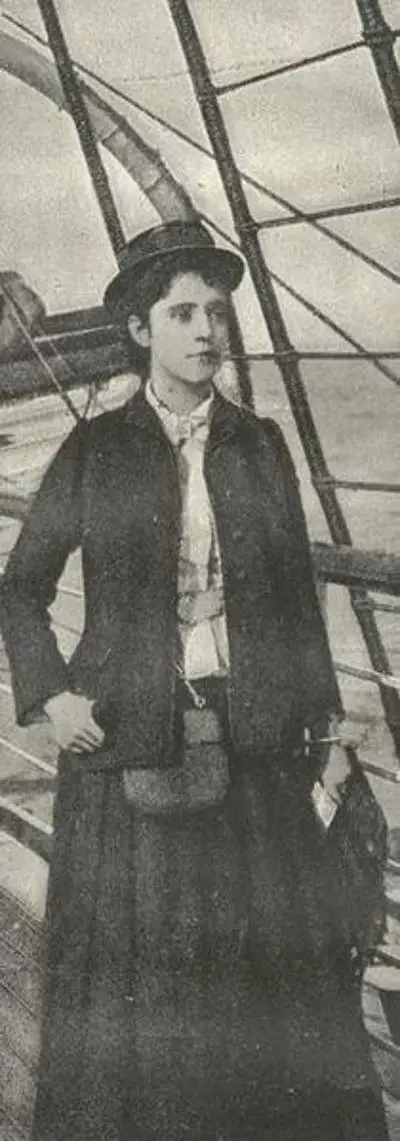
At the same time, Elizabeth Bisland, sponsored by the New York newspaper Cosmopolitan (she was also a reporter for the paper) also started to circumnavigate the world to beat the time of both Phileas Fogg and Bly. Bisland would travel the opposite way around the world.
Just over seventy-two days after her departure from Hoboken, Bly was back in New York. She had circumnavigated the globe, traveling alone for almost the entire journey. Bisland was, at the time, still crossing the Atlantic, only to arrive in New York four and a half days later.
She also had missed a connection and had had to board a slow, old ship (the Bothnia) in the place of a fast ship (Etruria). Bly’s journey was a world record, although it was bettered a few months later by George Francis Train, the original 80-day-circumnavigator, who completed the journey in 67 days.
Other Journeys
Since 1993, the Jules Verne Trophy has been given to the boat that sails around the world without stopping and with no outside assistance, in the shortest time.
- In 1903, James Willis Sayre, a Seattle theater critic, and arts promoter set the world record for circling the earth using public transport, 54 days, 9 hours, and 42 minutes.
- In 1908, Harry Bensley, on a wager, set out to circumnavigate the world on foot wearing an iron mask.
- In 1984, Nicholas Coleridge emulated Fogg’s trip and wrote a book entitled Around the World in 78 Days.
- In 1988, Monty Python alumnus Michael Palin took a similar challenge without using aircraft as a part of a television travelogue, called Michael Palin: Around the World in Eighty Days. He completed the journey in 79 days and 7 hours.
- In 2009, twelve celebrities performed a relay version of the journey for the BBC Children In Need charity appeal.
- In 2014, the Optimistic Traveler team consisting of Muammer Yılmaz and Milan Bihlmann completed the “80 Days Challenge”, a trip around the world without money, as the first step of their charity campaign for education in Haiti. They finished the journey in 79 days.

Read Around the World in Eighty Days
You can read the full novel on fullbooks.com.
Sources
- Jules Verne on Wikipedia
- Around the World in Eighty Days on Wikipedia
- Phileas Fogg (Around the World in Eighty Days) on Wikipedia
- Nellie Bly on Wikipedia
- George Francis Train on W
ikipedia
- Moon Landings: All-Time List [1966-2025] - February 2, 2025
- What Is Max-Q and Why Is It Important During Rocket Launches? - January 16, 2025
- Top 10 Tallest Rockets Ever Launched [2025 Update] - January 16, 2025
